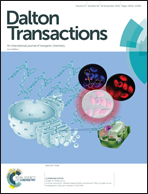Abstract
The azamacrocyclic complex was used as a platform for the construction of [3]rotaxanes containing two DB24C8 macrocycles per molecule. The complex unit incorporates two electron deficient π-bond systems and two N–H hydrogen bond donating groups which facilitated the formation of a 1 : 2 interlocked structure. Synthesis and properties of such compounds are presented. Structures of the obtained compounds were confirmed by NMR spectroscopy, ESI mass spectrometry, elemental analysis and single crystal X-ray diffraction. Both [3]rotaxanes containing two DB24C8 macrocycles per molecule crystallise in P![[1 with combining macron]](https://www.rsc.org/images/entities/char_0031_0304.gif) and P21/n space groups. They have different counterions (PF6− and Cl− anions, respectively) and mostly disordered solvent molecules such as water, methanol and acetone. Both [3]rotaxanes have a flexible axle in which the Cl− salt takes the shape closer to the “S”-letter, while in the PF6− case the axle is more linear. The shape results from respective packing and intra-, and intermolecular interactions among the moieties in the rotaxane and the crystal lattice.
and P21/n space groups. They have different counterions (PF6− and Cl− anions, respectively) and mostly disordered solvent molecules such as water, methanol and acetone. Both [3]rotaxanes have a flexible axle in which the Cl− salt takes the shape closer to the “S”-letter, while in the PF6− case the axle is more linear. The shape results from respective packing and intra-, and intermolecular interactions among the moieties in the rotaxane and the crystal lattice.
![Graphical abstract: [3]rotaxanes composed of two dibenzo-24-crown-8 ether wheels and an azamacrocyclic complex](/en/Image/Get?imageInfo.ImageType=GA&imageInfo.ImageIdentifier.ManuscriptID=C8DT03225D&imageInfo.ImageIdentifier.Year=2018)


 Please wait while we load your content...
Please wait while we load your content...